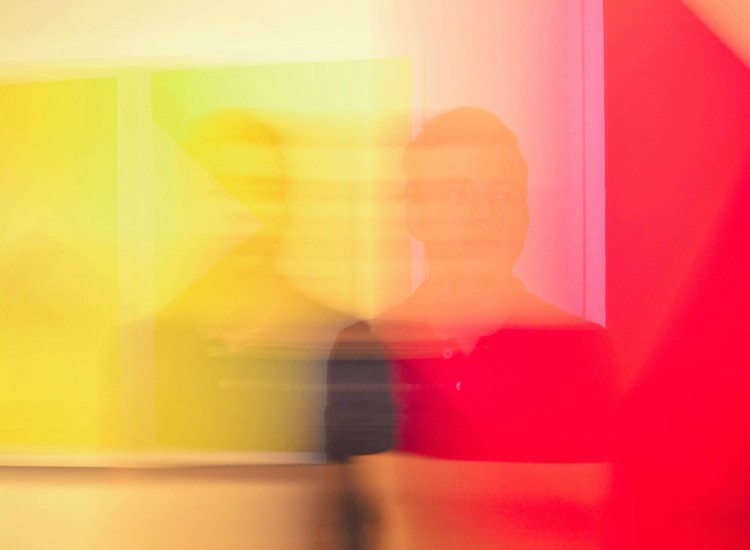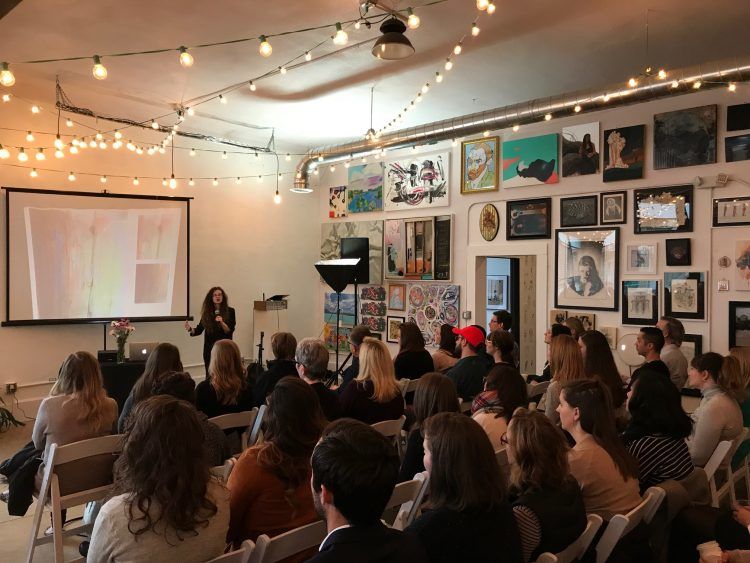A Firsthand View – Art Therapy and the Treatment of Anxiety

In group therapy, I ask members to “keep within their own experience.” No advice giving. No telling others how to feel. This helps create safety within the session. A college mentor of mine once said, “Never assume to understand the experience of someone else. Even if it’s one you’re familiar with, like sadness or fear. Thousands of lived experiences have made that sadness unique.”
Something similar happened to me last week. Creative Mornings asked me to share my experience of anxiety. Among the art at Lions & Rabbits, I told 150 creative professionals about my battle with Generalized Anxiety Disorder and my art therapy practice.

Below is part of the talk, Anxiety and Art Therapy:
I’ve worked with addiction, trauma, sexual assault… And one of the most common experiences I hear from my clients, across a number of presenting problems, is that the individual is also struggling with anxiety or depression.
From a clinical standpoint, we’re learning that anxiety and depression travel together. They can be expressed similarly or at the same time. One may feed the other… one may be stronger than the other… but they often occur together.
Feeling Anxious
Most of us have experienced anxiety. And most people describe that feeling as jittery, on edge, or nervous. When we’re anxious, we “worry excessively” (or more than what the situation warrants). Physical symptoms often accompany anxiety. These include nausea, rapid heartbeat, GI issues, or feelings of unreality.
We may feel anxious in the face of our phobias, before an important presentation, or during a life-threatening event. These anxiety responses are normal. Our brains have evolved to signal, “Something isn’t right! Take action!” when we need to make quick decisions. For some folks, however, anxiety occurs without a life-threatening event. And the anxious brain produces that signal over and over, regardless of what is going on, and as if something life threatening happening.
Lived Experience
And that’s exhausting. It’s no way to live. Anxiety prevents us from enjoying ourselves and living in the present. It can get in the way of our relationships, our passions, and our work.
My anxiety started at age 12 after a traumatic event. Sometimes, anxiety develops in response to our environment (at work, home, etc). Other times, folks begin to feel anxious “out of nowhere” and that anxiety builds until it becomes unmanageable. We also know that anxiety and depression are highly hereditary.

Speaking in front of a crowd can produce anxiety…
Art Therapy and Anxiety
I am an art therapist. Art therapy is a modality of mental health treatment that relies on metaphor and introspection. Art therapists utilize visual and tactile stimulation alongside traditional counseling techniques. We’re similar to talk therapists… we cover the same topics and have the same goals. But I incorporate art-making into my practice. And this helps to break down barriers to an individual’s ability to communicate.
So, for example, my nonverbal client can express how they’re feeling. My angry, uncooperative, teen client can tell me with her body language and choices how she’s feeling. My client who is so anxious that she can barely sit in the room with me can: self-sooth through art-making, help herself feel comfortable, and ground herself in the room. And then, together, we can be introspective about that experience.
Mark Making
In art therapy, we engage in “mark making.” My clients aren’t worried about technical training, expensive materials, properly using materials, or advancing their skills. We simply use art materials as a vehicle to express. We see a color or texture in our mind, and do our best to get it on the page.
I created this image when I was feeling anxious. What visual elements can you identify in this piece? Are the figures isolated? In pain? Look at the color, texture, shape, and choices the artist made. Notice how the artist chose to use the materials. Can you imagine the type of care took when she made this? Her motion and pace?
What do you notice about the line-work? Can you imagine how long it took to make this piece, or how soft or hard the artist was pushing down the material? The entire page has been filled. Are the figures are lost or obscured?
This image communicates a great deal. And it’s my role, as an art therapist, to give this artpiece a voice and facilitate the conversation.
In this way, we aren’t asking the artist directly, “How are you feeling?” We ask, “How is this image feeling?” It’s a small shift but it’s an important one. Especially when I’m sitting with someone who is struggling and unsure of whether (or how) to disclose information.
This art piece says to me,
I’m uncomfortable.
I’m trying to disappear.
I don’t want to be seen.
I can’t stop moving.
Disecting the Image
Now, I feel comfortable dissecting this image because I’m the one who created it. And when I’m with a client, I know the only person that can “explain” an art piece is the artist. When I sit with someone, I’m asking them to share their story. Stare at their story. Dissect their story. That story, or in this case the feeling of anxiety, sits on the page. It takes up space in the room, almost as a third person.
Because as we know, when you create something you put a piece of yourself into it. As an art therapist and an artist, I know my stories, emotions, opinions, and passions come out in my work. Even when I’m not trying to put them there. And even when I don’t want to include them.
Into Adulthood…
For me, as I grew into adulthood the object of my anxiety began to change. As a teen, we typically brood about our bodies… our clothing… looking “cool.” And I don’t mean to diminish those things, they feel like real issues while they’re happening. But as adults, we aren’t as focused on them anymore because they don’t define our identity. But other things do: Our partnerships. Financial status. Line of work and education.
My anxiety began to attach itself to my performance at work. I became anxious, or excessively worried, unfocused, and nauseous, while I was at work and when I thought about work. Which was constantly. (That’s the nature of the disorder, it doesn’t leave you. You can’t shut it off.)
Worrying Excessively
So now, I had moved past being an anxious teenager- excessively worried about my weight and looking like the outsider I convinced myself I was- to being an anxious adult woman. Who worried excessively about my ability to do my job well. Everything terrified me. And maybe terrified isn’t the right word- everything sent me into panic. Everything made me sick. So throughout my clinical internships and first positions as a therapist, my productivity went down. I didn’t complete projects. I missed work and lost jobs and said “No” to opportunities I should have said “Yes” to. All because I convinced myself I was an incapable fraud.
I thought I was just a perfectionist, an over-achiever. Except I wasn’t achieving anything because I was too busy throwing up in a bathroom to show up. My supervisors perceived that inability to show up as disinterest. In reality, I was too invested in the work. So now, in addition to feeling anxious about not doing my job perfectly, I was anxious about the fact that folks were seeing me as disinterested. (It’s a vicious cycle.)
Perception of Others
One thing you might notice is the emphasis I placed on the perceptions of others. The way my anxious brain convinced me that not only did I know what other people were thinking, but my worth depended on it.
So, I tried to figure out what was helpful to me. As I explained, “showing up” was difficult because I was frozen by the possibility of not executing everything perfectly. So I decided to simply notice those things that helped me feel less anxious. Or prevented me from becoming more anxious.
When I got home from work, I asked my body what it needed. And then I listened to what it told me. I sat on the floor… took a long drive… cleaned my shower… or went to sleep. Instead of feeding into the message, “You’re failing at this,” I was gentle with myself, the way I am gentle with my clients. Second, I spent time with people who helped me to feel less anxious because they inspired me, accepted me, and listened to me when I talked.
Self-Care
I also started an art ritual. \When I’m creating art, I feel present. I can’t think of anything else except what I’m doing. Art making is tactile, so it brings me back into my environment and out of my head. It’s repetitive and requires focus, so it soothes me. It also helps me feel confident and practice completing projects.
And the more I practiced these rituals- of listening to my body, being vulnerable with people I trust, and self-soothing through art- the less I beat myself up for feeling anxious. And the easier it became to handle my panic. Work was still a difficult thing for me, but it became easier when I addressed my anxiety and quit ignoring it or using it as a reason to speak harshly to myself. And although I still battle some anxieties, I know that it’s okay to feel anxious. I’m proud of myself for validating that and naming it. But after I do, it’s important to answer the question: “What am I doing about it?” Or, if things are really bad, “What am I able to do in this moment?”
I shifted the emphasis on the perception of others, and focused it inward.
And I encourage you to do the same. Listen to the messages your body tells you, the messages that come out in your work. Allow your artwork- whether its “work” art or “play” art (or “break up” art or “anxiety” art) to cue you into what you need. What you’re thinking about. Notice, be curious, look closely at the choices you make and the things you create. Be gentle with yourself as you allow yourself to improve.



